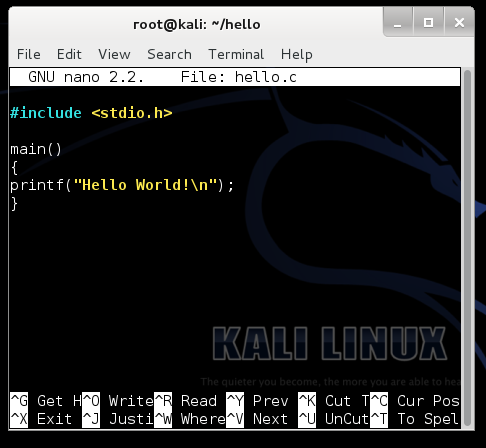
- HOW TO MAKE A NEW FILE IN TERMINAL IN C HOW TO
- HOW TO MAKE A NEW FILE IN TERMINAL IN C PC
- HOW TO MAKE A NEW FILE IN TERMINAL IN C WINDOWS
) with the text This is a text string inside the file. The below command will create a file called sample.txt in the current working directory (. Run the New-Item cmdlet specifying the directory to create the file in ( Path), the Name of the file, the type of item ( ItemType), and finally, the text to include in the file ( Value). We will make it a hidden file by appending a dot. 2.1 We will create a new bash script file where we will be keeping all of our commands.
HOW TO MAKE A NEW FILE IN TERMINAL IN C HOW TO
Related: How to use PowerShell to Check if a File Exists (Examples)ġ. Step 2: Making a place to keep all of your custom commands.
HOW TO MAKE A NEW FILE IN TERMINAL IN C WINDOWS
The New-Item cmdlet can also create Windows registry keys or folders. One of the easiest ways to create a file in Windows with PowerShell is to use the New-Item cmdlet This cmdlet creates new items (a file in this case). So, open your Windows PowerShell or PowerShell console and let’s get started! Using the New-Item Cmdlet It’s now time to use a more modern approach of using a Windows command prompt to create a file with PowerShell! PowerShell has a few different ways to create a file so let’s cover them all. Since the fsutil utility can create blank files of a certain size, the utility is great for creating dummy files for network performance testing! Creating a File with PowerShell 4.To save the file: Press Esc button and then type :wq.It will save the file. To Edit the file: 3.Press i to go to insert mode. When you’ve created the file, run the dir command to list all files in the current working directory vim file.c (file name can be anything but it should end with dot c extension) command. But, since the command is using the redirection operator ( >), this operator tells Windows to instead create a file with the text ( sample.txt). This command echoes the text provided ( This is a sample text file) to the command console. In Windows, if you can send something to the command console, you can also redirect that output to a file!ġ. The echo command is a command-line utility that allows you to display messages in a command prompt. This will open a Terminal window in the current working directory. Select the option that says New Terminal at Folder. Here, you’ll see a number of different services.

Next, navigate to the Finder -> Services menu within the toolbar. First, select a folder where you’d like to create your file from within the Finder. Let’s start this tutorial by first covering the echo command. Using Terminal to Create a New Blank Text File in Any Folder.

The Windows command prompt should come up, and you’re ready to go. To get started, open the Windows command prompt by clicking on the Start button, typing cmd.exe, and hitting Enter. Let’s first cover how to use the Windows command prompt to create a blank file. You have two command-line options in Windows the command prompt ( cmd.exe) or PowerShell.

HOW TO MAKE A NEW FILE IN TERMINAL IN C PC
A Windows PC – All demos in this tutorial will use Windows 10, but Windows 7+ will work also.If you’d like to follow along with the steps in this tutorial, be sure you have the following ahead of time: Using the Set-Content and Add-Content Cmdlets.Creating a File with the Windows Command Prompt.


 0 kommentar(er)
0 kommentar(er)
